Call to Arms for Geebung Mothers
On the 23rd of August, 1947, a brief article appeared in the Courier Mail calling on Geebung mothers to assemble at 3pm in the Geebung Memorial Hall, now Geebung RSL, [zotpressInText item=”{57GHRQ9A}”] to consider a proposal to form a district child-care centre [zotpressInText item=”{8X2U65F5}”]. The convenor of the meeting was Mrs G Donaldson of Robinson Road, Geebung. Gwenda Donaldson, née Laughton, had recently moved to the area with her husband, Robert (Bob), and two sons, Peter and Chris, with another (Ian) on the way. Gwenda was joined by five other local mothers who were determined to establish a child minding centre for the benefit of the district [zotpressInText item=”{U89REN8V}”].
These women would go on to establish the first child care centre and kindergarten in Geebung. The centre moved several times over its history. From an entirely volunteer-run enterprise, supported by local businesses and the fundraising efforts of the volunteers, eventually it evolved into a modern and professional kindergarten and preschool that still exists today.
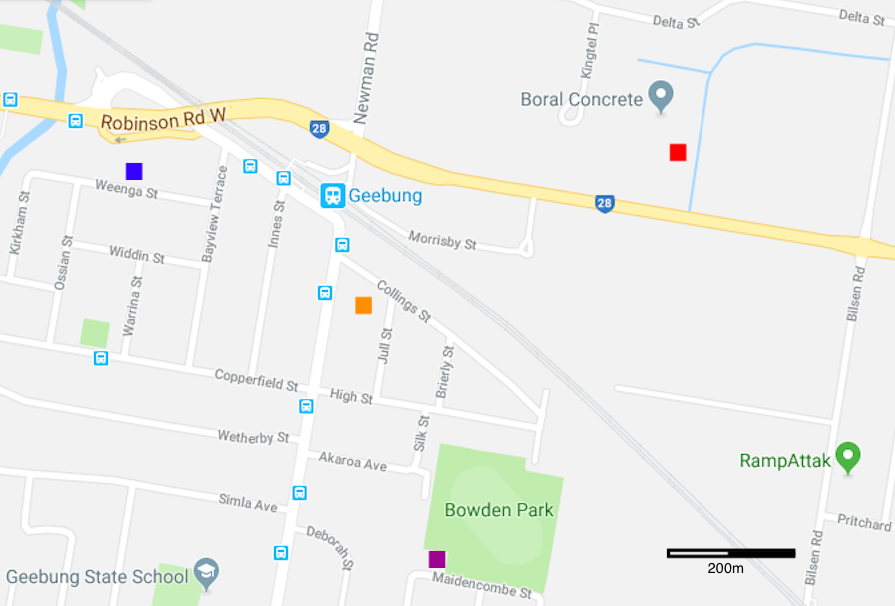
Map: Google Maps. Annotations: J Donaldson.
A Community Need
The need for a kindergarten in the area was raised with local government as early as 1929 when the Zillmere-Geebung branch of the Country and Progressive National Party applied to Mr R.M. King, Minister for Works and Education and “asked that action should be taken for the establishment of a kindergarten school at a convenient place in the district.” [zotpressInText item=”{NSMMAZJG}”] This request was denied due to the large number of such requests and the lack of available funds. It took a further 20 years before the district’s need was met.
Before moving to the area in 1947, Gwenda Donaldson was a volunteer with the Clayfield Child Minding Centre. According to Kath Ballard, Geebung’s historian, early support for the proposal came from Mr Leon Black who donated 5 pounds towards the centre in 1947. However, no further support was forthcoming as Geebung locals in the late 1940s seemed happy to continue without childcare services. The issue lapsed for two years due to lack of support [zotpressInText item=”{QRFBAJ68,206}”].
In these early years, Gwenda struck up a friendship with Mrs Audrey Schlenker of Zillmere, which proved important in the history of the Child Minding Centre. According to Ian Donaldson, Audrey and her husband Laurence owned a farm in Zillmere and had children of similar age to the Donaldson’s. Audrey had noticed Gwenda walking to and from Geebung station at the bottom of Robinson Road and one day stopped to give her a lift in her farm truck; from that point on they were close friends. Both women went on to be leading figures in the Geebung Child Minding Centre.
The Centre Opens – Geebung Memorial Hall
When approached by Gwenda about the Child Minding Centre, Audrey’s Schlenker’s opinion was that “It is useless to call public meetings in Geebung – the thing to do is go ahead and open a centre and when the people see that it is an accomplished fact, they will support it.” As a result, in 1949, seven women: Gwenda Donaldson, Doreen Thomsett, Audrey Schlencker, Mrs K Blackmore, Mrs WG Burns, Mrs L Watts (Beryl or Ev?), and Mrs FW Talbot (Edna?) formed the Geebung Child Minding Centre Committee [zotpressInText item=”{QRFBAJ68,220}”].
On Monday 21 March 1949, we find our next piece of evidence concerning the Geebung Child Minding Centre, in the form of a brief article in the Courier Mail [zotpressInText item=”{7WFX8PGF}”]. The long-awaited centre would open in the Geebung Memorial Hall the following Thursday for one day a week and was to be run by the Women’s committee of the Geebung Progress Association. Calls were made for further contributions of equipment [zotpressInText item=”{YAC9IQDI}”] and rental of the hall cost 1 shilling for the day.
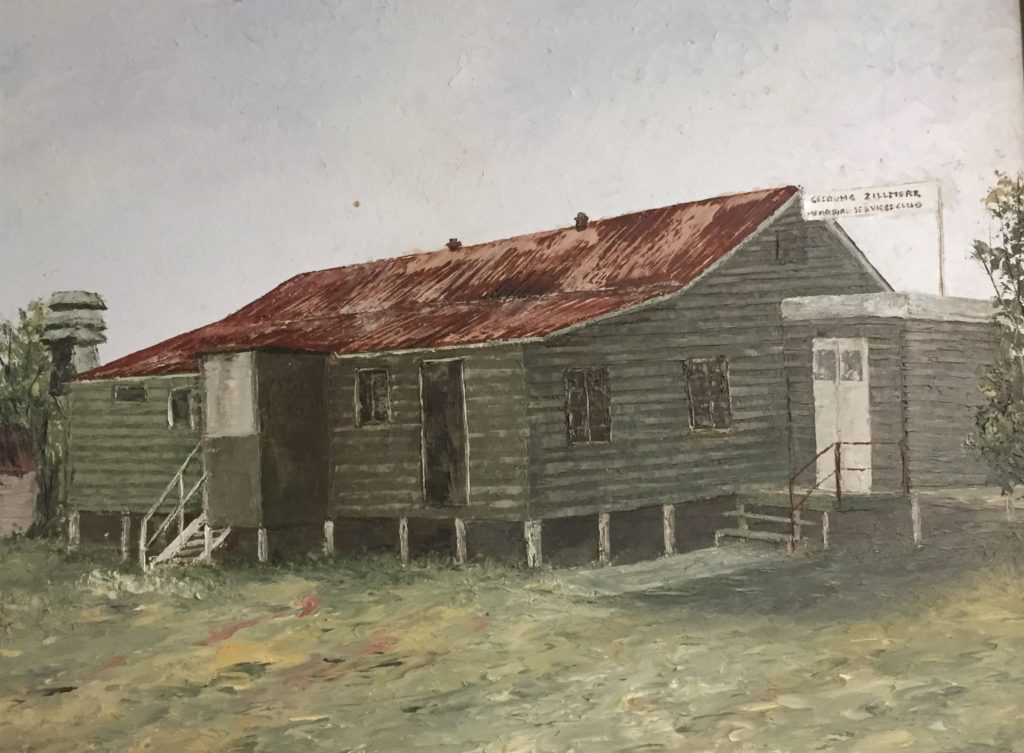
Geebung Memorial Hall Painting by DJ Kavanagh at Geebung-Zillmere RSL Club 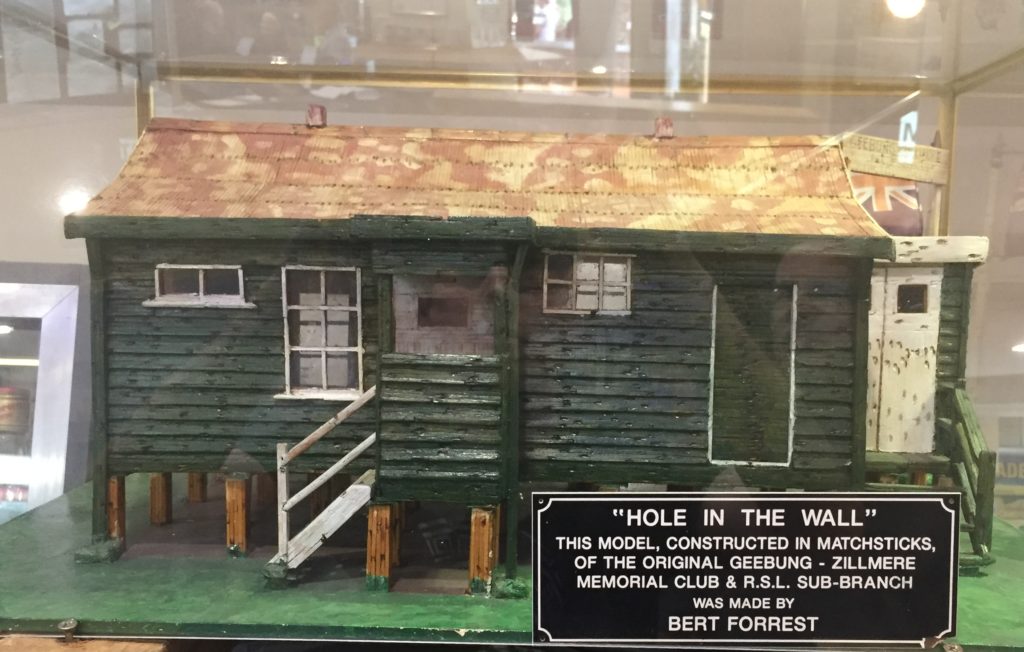
“Old Hole in the Wall” Model by B Forrest at Geebung-Zillmere RSL Club 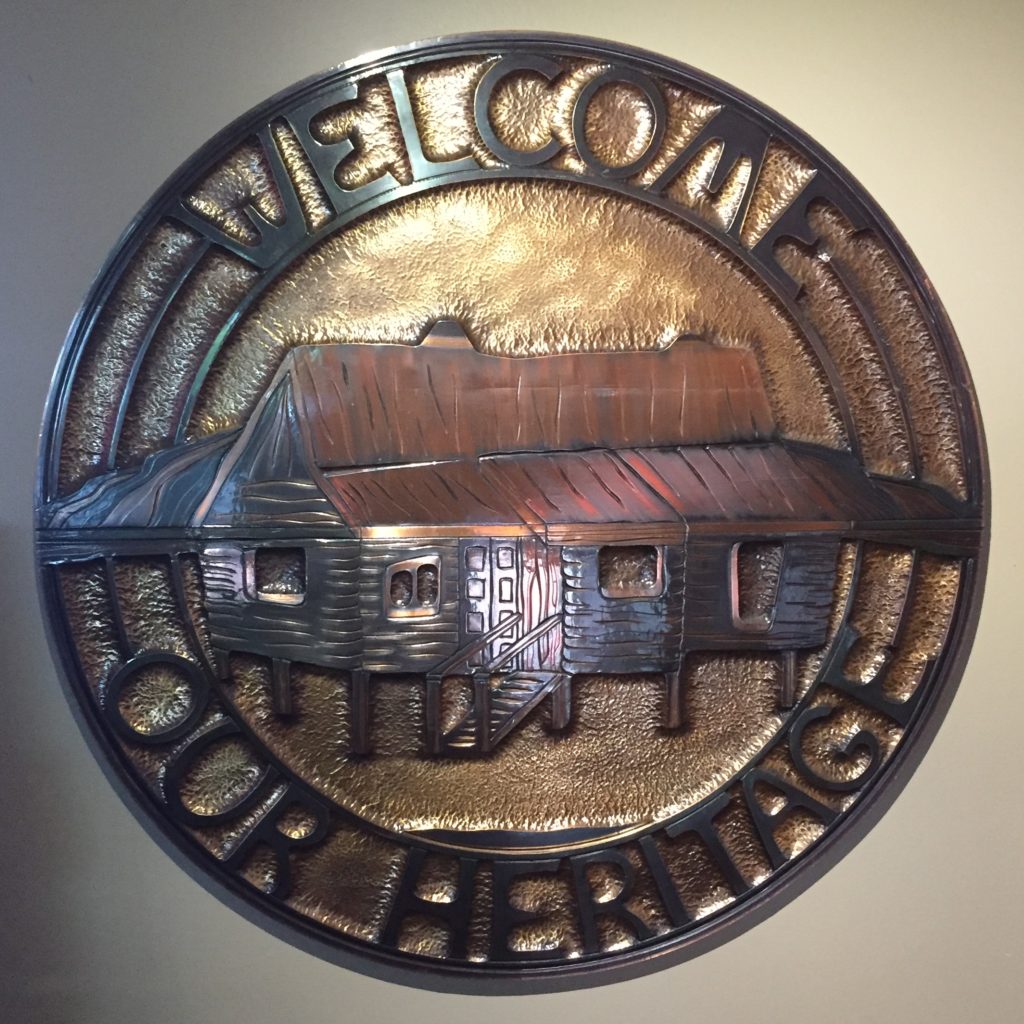
Bronze Heritage Logo featuring Memorial Hall at Geebung-Zillmere RSL Club
The challenge of providing the necessary funds to keep the centre afloat, and eventually provide a more permanent home, was taken up by the committee and over the next few years a number of articles detail their progress. In September 1950 the first children’s fancy-dress ball was held in the Geebung Memorial Hall, opened by the Lady Mayoress, Mrs JB Chandler [zotpressInText item=”{PSMTQABX}”]. By December of the same year, 15 mothers had raised some 105 pounds towards the establishment of a permanent centre and were supported by local businesses [zotpressInText item=”{U89REN8V}”]. Lunches of “mash” (savoury mince) were made with produce from Robinson’s store and three bottles of milk were provided free of charge for morning tea. Ian Donaldson notes that this was known as “Robbie’s Store” and was located on the corner of Newman Rd and Railway Pde. The Robinson’s daughter, Norma, married Frank Sleeman, from the news-agency next door in 1945: Frank would later become Lord Mayor of Brisbane from 1976 – 1982 [zotpressInText item=”{LF2S3CV5}”].
The centre was only open Thursdays, from 9:30am – 4:30pm, which allowed mothers to catch the 9:45am train to the City [zotpressInText item=”{QRFBAJ68,221}”] and a voluntary roster system staffed the centre with 5 women each week, catering to the needs of 20 children. However, Mrs R Tapper, secretary of the centre, noted that despite the funds raised, more was needed in the following year to being work on the centre’s permanent home.
Challenges to Success
The Memorial Hall itself was largely filled with chairs as it was also used as “The Grande” picture theatre, and the child minding centre’s equipment was stored at one end of the verandah. At the other end was a kitchen, added in 1949, where meals could be prepared and according to Peter Donaldson, a ‘mothercraft sister’ used to visit and check on the babies. The dual function of the Hall put a considerable strain on the committee as they had to move equipment into and out of the verandah area each Thursday to allow others to use the hall for the rest of the week [zotpressInText item=”{QRFBAJ68,242}”].
Other issues also cropped up – the centre was forced to shut down for several weeks on at least one occasion owing to illness among the volunteer staff [zotpressInText item=”{NQXY2KTQ}”] and savings for a permanent home were hard to come by even with donations. However, philanthropy was to continue to assist the volunteers in their mission to give excellent care to the area’s children: in 1954 they received two monetary donations, one of which allowed them to purchase a piano for the centre [zotpressInText item=”{87T2B3X4},{AR5AJEK7},{F4TNB7AS}”].
As the staff were all volunteers, the centre appears to have closed over the Christmas break and reopened late in January [zotpressInText item=”{8EXGQD8X}”]. It also opened on the Tuesday of exhibition week in 1951 [zotpressInText item=”{93RV28FI}”], in addition to its regular Thursday session. Later that year the fees rose from 1/6 to 2/6 per child, capped at 4/ per family [zotpressInText item=”{S9ANL4XK}”]. Reportedly these fees were quite low for the period and still included the usual hot lunch, morning tea and afternoon snack, but the centre was still in need of additional volunteers and toys. In the 1950s Ian and Peter Donaldson recall that the hot lunch was still the regular savoury mince with vegetables served in small soft plastic, pastel coloured bowls that flavoured the whole meal of plastic. Ian has vague memories of hessian sacks laid out as bedrolls in the hall around this period too.
A New Home – Robinson Road, Geebung
The hard work of the centre’s volunteers finally paid off in 1952 with the addition of 50 pounds to their funds thanks to the Courier Mail’s “Find-the-ball” competition and the Young Women’s Christian Association [zotpressInText item=”{7RIDAHPP},{4NW47YXU},{QT7Y23AR}”]. Ian Donaldson recalls that ‘Mater’ (Gwenda) was a big fan of the find the ball competitions throughout her life. These competitions involved marking the location of a ball “photoshopped” out of a picture of a cricket match or similar; the first winning entry took the prize.
In the early 1950s, over 1100 children had benefited from the centre’s services and plans were underway to purchase a building as a permanent home. This finally occurred in April 1952 when an ex-army hut was positioned on the grounds of the Industrial Sales and Services (ISAS) Ltd on Robinson Road [zotpressInText item=”{WYII3EP3},{GMRXVKKJ},{QRFBAJ68,242}”]. Ian Donaldson recalls that the hut was purchased for 20 pounds at auction (according to Peter Donaldson, from the army camp between Newman Road and Marchant Park) and the land was given free of charge from the bottom portion of the ISAS land in what is now Robinson Road East (see map, above). Peter Donaldson recalls the land was very boggy as it was down by the creek that runs from the present day industrial estate of Robinson Road East, into the Zillmere waterholes. To make it more solid, Peter remembers being tasked with spreading ash cinders from a power station over the ground which was then covered with topsoil to grow grass. The centre was finally opened in November 1952 by Mr E Decker, the member for Sandgate, with materials, paint and labour provided by local businesses [zotpressInText item=”{XC9AYC9T}”].
Plans for Expansion
The twenty women now operating the centre had high hopes for its future, with plans to expand the number of days the centre was opened each week from one to four. The new centre boasted a playroom and kitchen, nursery, and a toilet. The volunteers were soon supplemented by paid staff: a young woman initially provided childcare services two days a week, and later, a Mrs Kefford was engaged to run the kindergarten [zotpressInText item=”{QRFBAJ68,243}”].
In the three years to November 1952, an article in the Sunday Mail records 2475 children had passed through the centre [zotpressInText item=”{XC9AYC9T}”]. The expansion of industry into Geebung, and the success of the child minding centre were seen as evidence that the suburb was “growing up”.
Opening of the Centre – 1952
A photograph, taken at the opening of the centre is held by the Donaldson family. It shows 19 of the centre’s 20 volunteers standing outside of the repurposed army hut at its opening in 1952. Most of the women are named in a label under the image and some information about them, provided by Ian Donaldson, is available on the object record. Five of the women originally responsible for founding the centre are pictured: Gwenda Donaldson, Audrey Schlenker, Doreen Thomsett, Edna Talbot and Beryl or Ev Watts.
[ehive_object_details object_record_id=”544510″]
Another image from the day was published by Kath Ballard in her Geebung Story [zotpressInText item=”{QRFBAJ68,243}”].
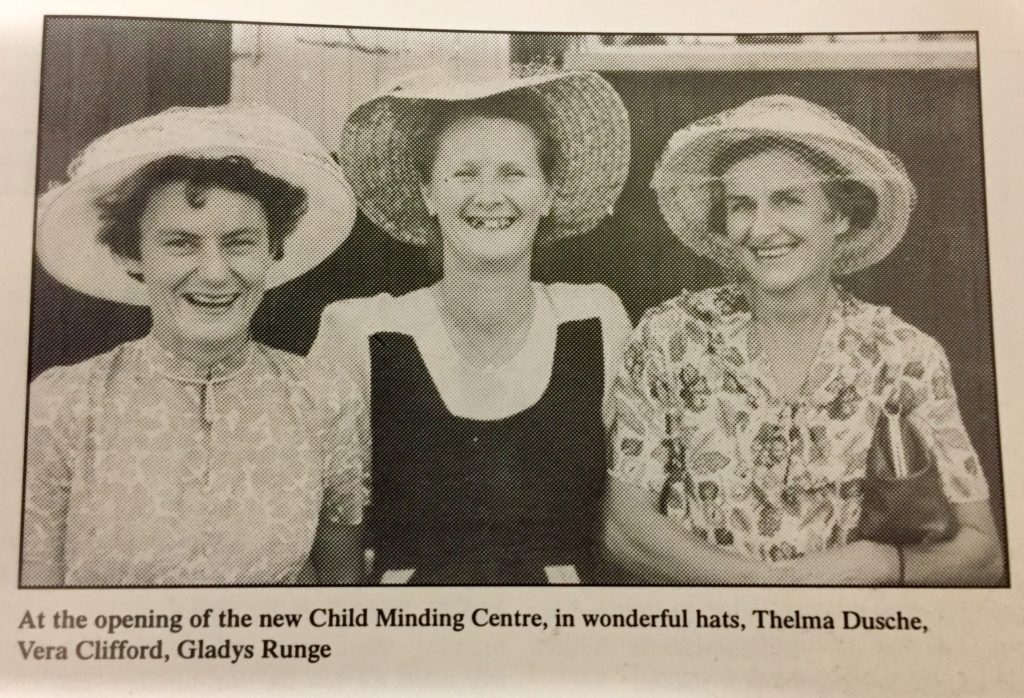
On the Move Again – Weenga Street, Geebung
The Geebung Child Minding Centre is more difficult to track down from the newspapers records after 1954, as the more recent editions have not yet been digitised. However, the story of the centre continues.
In the period from 1954 to 1966 the population of Geebung more than doubled from some 7,000 people to over 18,000 in 1966. As a result, demand on childcare services increased proportionally [zotpressInText item=”{CEQPXLJ4}”]. In 1959, after close to 7 years of operation, ISAS wanted to sell the land on which the Child Minding Centre was located to Paul’s Milk for a new depot. The local community gathered together and moved the original ex-army hut Robinson Road to nearby Weenga street, after a number of other possible locations fell through. [zotpressInText item=”{QRFBAJ68,269}”].
In the intervening years, the centre had increased its days from 2 to 4, and Mrs Kefford was replaced by Mrs Garvey, and then Miss Batson (until c. 1963), both trained kindergarten teachers. Volunteers continued to assist on a weekly roster, including Kath Ballard, who recalls collecting the “kindy” children from the corner of Robinson and Newman Roads [zotpressInText item=”{QRFBAJ68,269}”].
Ian Donaldson recalls his father, Robert “Bob” Johnstone Donaldson helping with the relocation and walking with him down from their house on Robinson Road to have a go (along with all the local kids) at the jackhammer used to dig the foundations for concrete footings on the new Weenga St site. The relocated building boasted a minimum flush septic system toilet.
Unfortunately, Doreen Thomsett, one of the founders of the centre, died in 1959 before the Weenga street centre opened. A Colvillea tree was planted in the grounds in her memory. [zotpressInText item=”{QRFBAJ68,269}”].
New Beginnings – Maidencombe Street, Geebung
In 1965 the centre became an exclusive preschool organisation and in 1966 the decision was made to join the Creche and Kindergarten Association and move the centre again to its current location in Maidencombe Street, Geebung [zotpressInText item=”{VHWGWUHP}”]. The present day kindergarten and preschool no longer provides childcare services, but prepares almost 100 local children for school each year.
The Weenga Street building was not moved or demolished and still exists as a residence today. In the picture below, the original centre is the main portion of the building to the left and the original windows, visible in the image of the centre’s opening at Robinson Rd in 1952, can still be seen.
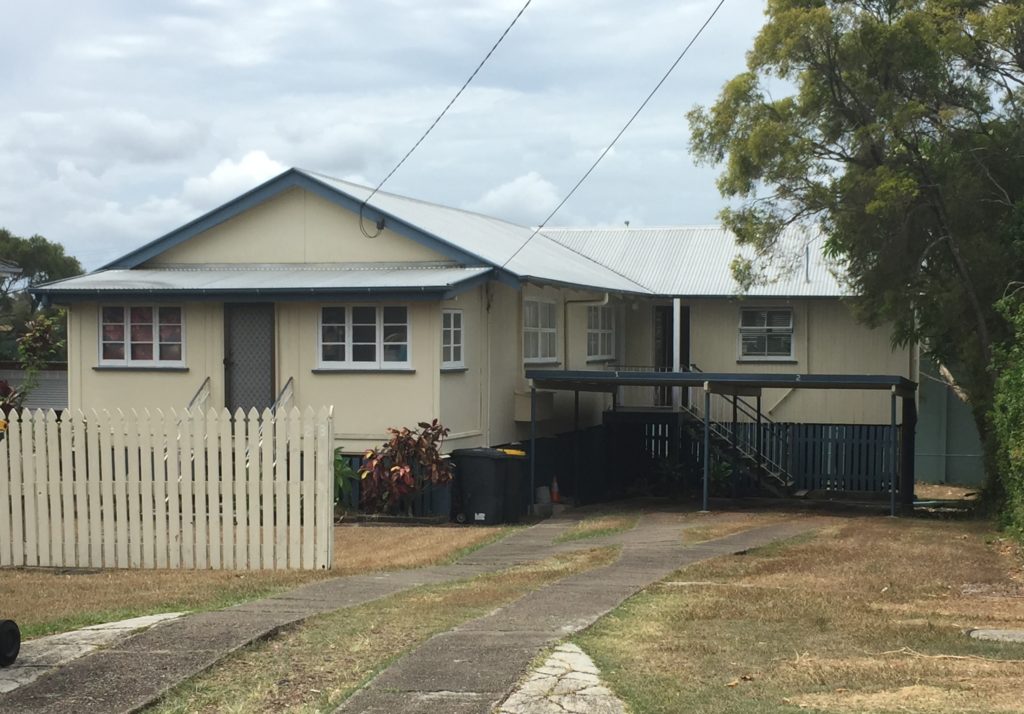
With these significant changes in the early 1960s, and the introduction of new government regulations around childcare, the remaining members of the Child Minding Committee disbanded and the centre became a professional organisation. However, it was only through the hard work of these dedicated local women that the organisation existed at all, founded on principles of low cost, excellent care and community mindedness, and persisted for almost 70 years.
Do you remember attending the Geebung Child Minding Centre? Do you have photos to share? I’d love to hear from you in the comments below!
Thanks to Judy Clarkson for assistance in sourcing Kath Ballard’s book on Geebung, and for sharing her memories of the centre and Mrs Kefford via the Old Brisbane Facebook page.
[zotpressInTextBib style=”apa” sort=”ASC”]
Leave a Reply